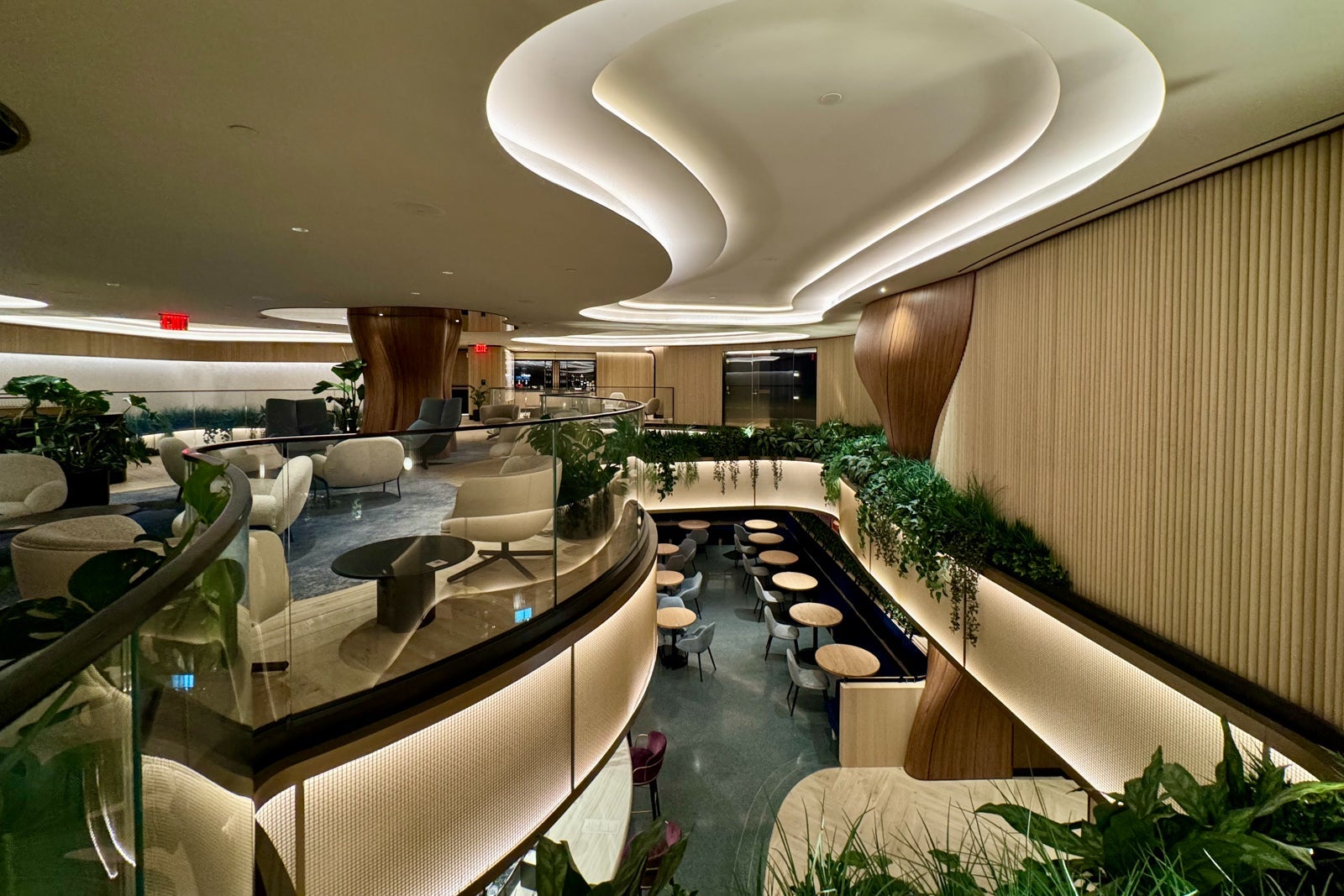The Chase Sapphire Preferred® Card (see rates and fees) and the Chase Sapphire Reserve® (see rates and fees) are two of our all-time favorite travel rewards credit cards.
Both cards are great for those looking to earn valuable Chase Ultimate Rewards points, but that’s where the overlap ends. The Sapphire Preferred is a popular mid-tier travel card but lacks many of the premium perks offered by its big sibling, the Sapphire Reserve.
The Sapphire Reserve has a $795 annual fee, $700 more than the $95 annual fee of the Sapphire Preferred. With the recent Sapphire Reserve refresh, you can now hold both cards at once, but just because you can doesn’t mean you should.
Here are six compelling reasons to consider upgrading your Sapphire Preferred to the Sapphire Reserve.
Airport lounge access
Lounge access is a nice way to escape the hustle and bustle of the terminal. Lounges provide complimentary food and beverages, comfy seating, workspaces, and the occasional shower.

While the Sapphire Preferred doesn’t offer any lounge access, you can get into the following lounges with the Sapphire Reserve:
- Chase Sapphire lounges: Cardholders receive entry for themselves and two complimentary guests into Chase Sapphire lounges. These lounges are excellent and rival American Express’ Centurion Lounges in quality. There are currently eight lounges open, with confirmed plans for three more on the way.
- Priority Pass lounges: Cardholders can enter over 1,700 Priority Pass lounges worldwide and bring two complimentary guests ($27 per person for additional guests after the first two).
- Select Air Canada Maple Leaf lounges: When flying on a Star Alliance carrier, cardholders can enter over 20 Air Canada Maple Leaf lounges and bring in one complimentary guest.
Plus, authorized users on Chase Sapphire Reserve accounts (each costing $195 per year) can enter Sapphire lounges and receive a full Priority Pass membership.
Related: Your guide to Chase’s trip insurance coverage

Daily Newsletter
Reward your inbox with the TPG Daily newsletter
Join over 700,000 readers for breaking news, in-depth guides and exclusive deals from TPG’s experts
Improved trip delay insurance
From firsthand experience, this insurance really matters, especially when your trip is delayed.
The Sapphire Preferred provides up to $500 per ticket for delays of at least 12 hours or those requiring an overnight stay. The Sapphire Reserve provides the same $500 coverage amount, but it kicks in after just six hours.

After a delay of six hours, you can be reimbursed for essential items like food, transportation, a hotel stay and toiletries you may need because of your delay.
Related: Should you get travel insurance if you have credit card protection?
Better redemptions with Points Boost
One way to redeem your points is for travel booked through Chase Travel℠. You can redeem points at a fixed value with Chase Travel or use the new Points Boost redemption option.
With Points Boost, you can get up to 1.75 cents per point with the Sapphire Preferred but up to 2 cents per point with the Sapphire Reserve when redeeming points on select Chase Travel bookings. While the difference may appear minor, it quickly adds up when redeeming large amounts of points through Chase Travel.
Note that TPG credit cards writer Danyal Ahmed found that to receive these elevated redemption rates, you have to book premium cabins on select airlines such as Air Canada and United Airlines or book hotels via The Edit.
Related: What’s the difference between Chase’s The Edit properties and Points Boost?
Higher earning rates
The Sapphire Reserve earns:
- 10 points per dollar spent on Peloton equipment and accessory purchases of $150 or more (through Dec. 31, 2027), with a maximum of 50,000 points
- 8 points per dollar spent on purchases made through Chase Travel, including The Edit
- 5 points per dollar spent on Lyft rides (through Sept. 30, 2027)
- 4 points per dollar spent on flights and hotels booked directly
- 3 points per dollar spent on dining worldwide
- 1 point per dollar spent on all other purchases

Meanwhile, the Sapphire Preferred earns:
- 5 points per dollar spent on travel booked through Chase Travel
- 5 points per dollar spent on Peloton purchases of $150 or more (through Dec. 31, 2027), with a maximum of 25,000 points
- 5 points per dollar spent on Lyft (through Sept. 30, 2027)
- 3 points per dollar spent on dining
- 3 points per dollar spent on select streaming services
- 3 points dollar spent on online groceries (excludes Target, Walmart and wholesale clubs)
- 2 points per dollar spent on all other travel
- 1 point per dollar spent on all other purchases
Despite the Sapphire Preferred earning 2 points per dollar spent on all travel, which Chase broadly defines, the Sapphire Reserve is better suited for those who book more flights and hotels directly. It earns 4 points per dollar spent in these categories, an 8.2% return based on TPG’s August 2025 valuations, making it one of the best cards to use for these purchases.
Lastly, if you book travel frequently through Chase Travel, the Sapphire Reserve earns 8 points per dollar spent, whereas the Sapphire Preferred only earns 5 points per dollar spent. If you’re frequently booking travel this way, it can make the Sapphire Reserve a more rewarding option.
Related: Chase Ultimate Rewards sweet spots: From international business class to domestic travel
Complimentary elite status
If you’ve been looking to acquire hotel elite status, you’re in luck as the Sapphire Reserve offers automatic IHG One Platinum Elite status (through Dec. 31, 2027).
This status provides benefits like earning 60% bonus points on stays, complimentary upgrades, early check-in and 2 p.m. late checkout (when available).
Related: IHG One Rewards: How to earn and redeem points, elite status and more
Plentiful statement credits
The Chase Sapphire Reserve offers an impressive set of statement credits, totaling over $2,000 in annual value when fully utilized. Most of these credits are easy for the average cardholder to take advantage of, especially the Apple, dining, StubHub and travel credits.

Meanwhile, the Sapphire Preferred offers a $50 annual hotel statement credit each cardmember anniversary year for hotel bookings made through Chase Travel (the first $50 in Ultimate Rewards hotel purchases will not earn rewards points). If you’re able to use this credit, it brings the Sapphire Preferred’s effective annual fee down to just $45.
If you can use even half of the credits offered on the Sapphire Reserve, that will more than cover the annual fee, making the upgrade easily justified.
Related: Why I’ll never cancel my Chase Sapphire Reserve
How to upgrade to the Chase Sapphire Reserve
There are two ways to “upgrade” to the Sapphire Reserve, with the first one being my recommendation.
Downgrade your Sapphire Preferred first
Chase has new rules regarding welcome bonus eligibility on its Sapphire cards, and not everyone will be eligible for a bonus.
You may qualify for the Sapphire Reserve welcome bonus if you’ve never received a Sapphire Reserve welcome bonus before, and you’re not an active Sapphire cardholder (including the Sapphire Preferred).
Here’s how to do it: First, downgrade your Sapphire Preferred to either the Chase Freedom Flex® (see rates and fees) or the Chase Freedom Unlimited® (see rates and fees). Then, wait at least a week and apply for the Sapphire Reserve.
To learn more, check out our guide on the Sapphire Reserve welcome bonus eligibility.
Related: Am I eligible for the Chase Sapphire Reserve’s bonus?
Product change
The easiest way to upgrade to the Sapphire Reserve is to product change. This means converting your Sapphire Preferred to a Sapphire Reserve. If approved, you’ll keep your same account and card number — but you won’t earn the Sapphire Reserve welcome bonus.
To downgrade or upgrade your card, call the number on the back of your card or log in to the Chase app and send a secure message. Say that you’d like to product change your card, and follow the representative’s instructions.

It’s important to note that, since the Sapphire Reserve is a Visa Infinite card, you’ll need at least a $10,000 credit limit. If your Sapphire Preferred doesn’t have that high of a credit limit, you’ll need to first request a credit limit increase. A Chase representative confirmed this with me when I was looking into upgrading my Sapphire Preferred.
Related: Your biggest Chase Sapphire Reserve questions answered: From bonus eligibility to earning rates
Hold both Sapphire cards
Since you’re allowed to hold both Sapphire cards, you can apply for the Chase Sapphire Reserve while keeping your Sapphire Preferred. If approved, you’d pay a combined $890 in annual fees, but this pairing can offer excellent value with strong points-earning potential.
To further boost your rewards, consider adding the Chase Freedom Unlimited to complete the Chase Trifecta. With this setup, you’d earn at least 1.5 points per dollar spent on all purchases, maximizing your return across spending categories.
Just remember, you’ll be subject to Chase’s 5/24 rule when applying for the Sapphire Reserve — and you won’t earn the Sapphire Reserve welcome bonus.
Related: When should you ignore Chase’s 5/24 rule?
Bottom line
For frequent travelers, the Sapphire Reserve is worth it over the Sapphire Preferred. Perks like lounge access, statement credits and higher Points Boost redemption rates through Chase Travel are key reasons to upgrade.
The Sapphire Preferred is still an excellent travel rewards card for casual travelers who don’t need lounge access or premium perks. But if you fly even a few times a year and don’t already have a travel rewards card with similar perks, the Sapphire Reserve is a better pick.
For more details, read our full review of the Sapphire Preferred and Sapphire Reserve cards.
Apply here: Chase Sapphire Preferred
Apply here: Chase Sapphire Reserve


